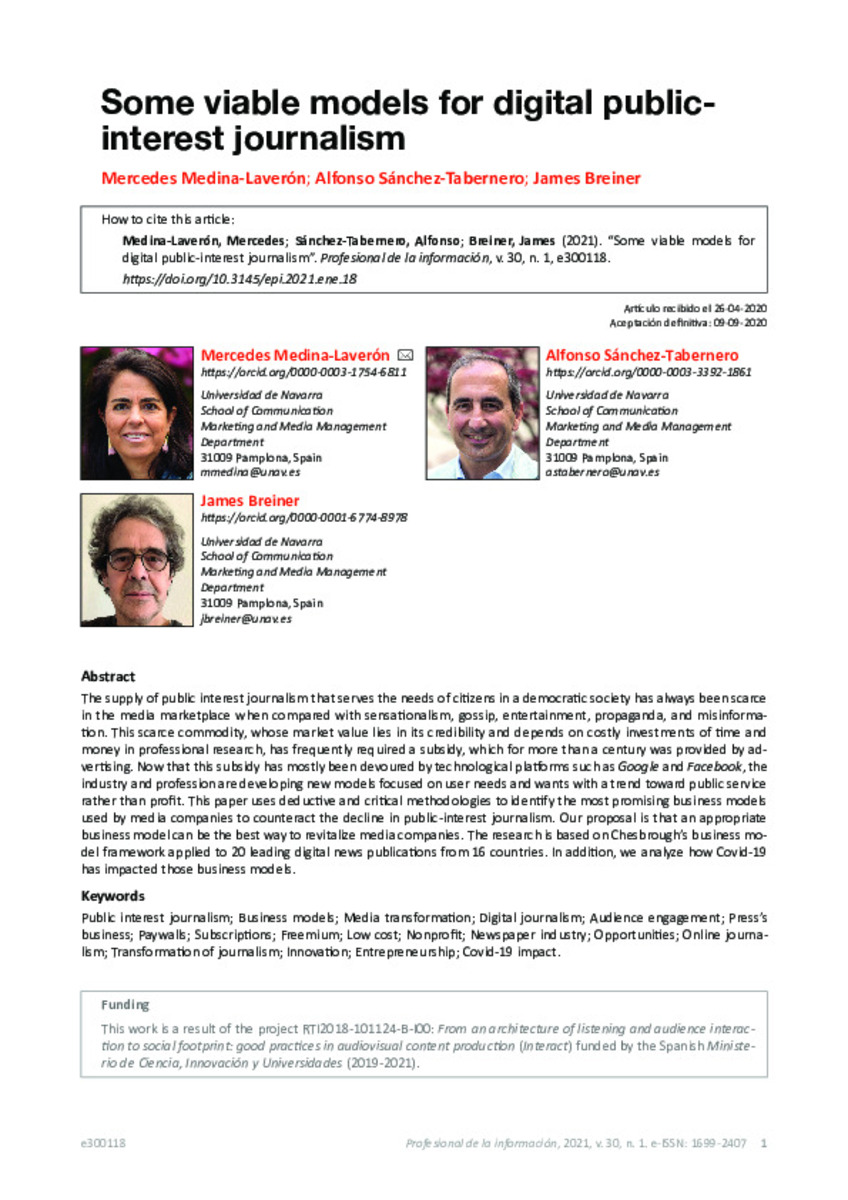Full metadata record
| DC Field | Value | Language |
|---|---|---|
| dc.creator | Medina, M. (Mercedes) | - |
| dc.creator | Sánchez-Tabernero, A. (Alfonso) | - |
| dc.creator | Breiner, J.G. (James Gerard) | - |
| dc.date.accessioned | 2022-10-04T10:56:53Z | - |
| dc.date.available | 2022-10-04T10:56:53Z | - |
| dc.date.issued | 2020 | - |
| dc.identifier.citation | Medina, M. (Mercedes); Sánchez-Tabernero, A. (Alfonso); Breiner, J.G. (James Gerard). "Some viable models for digital public-interest journalism". Profesional de la información. 30 (1), 2020, e300118 | es_ES |
| dc.identifier.issn | 1699-2407 | - |
| dc.identifier.uri | https://hdl.handle.net/10171/64372 | - |
| dc.description.abstract | The supply of public interest journalism that serves the needs of citizens in a democratic society has always been scarce in the media marketplace when compared with sensationalism, gossip, entertainment, propaganda, and misinformation. This scarce commodity, whose market value lies in its credibility and depends on costly investments of time and money in professional research, has frequently required a subsidy, which for more than a century was provided by advertising. Now that this subsidy has mostly been devoured by technological platforms such as Google and Facebook, the industry and profession are developing new models focused on user needs and wants with a trend toward public service rather than profit. This paper uses deductive and critical methodologies to identify the most promising business models used by media companies to counteract the decline in public-interest journalism. Our proposal is that an appropriate business model can be the best way to revitalize media companies. The research is based on Chesbrough’s business model framework applied to 20 leading digital news publications from 16 countries. In addition, we analyze how Covid-19 has impacted those business models. | es_ES |
| dc.description.sponsorship | This work is a result of the project RTI2018-101124-B-I00: From an architecture of listening and audience interac- tion to social footprint: good practices in audiovisual content production (Interact) funded by the Spanish Ministe- rio de Ciencia, Innovación y Universidades (2019-2021). | es_ES |
| dc.language.iso | eng | es_ES |
| dc.publisher | EPI | es_ES |
| dc.rights | info:eu-repo/semantics/openAccess | es_ES |
| dc.subject | Public interest journalism | es_ES |
| dc.subject | Business models | es_ES |
| dc.subject | Media transformation | es_ES |
| dc.subject | Digital journalism | es_ES |
| dc.subject | Audience engagement | es_ES |
| dc.subject | Press's business | es_ES |
| dc.subject | Paywalls, Subscriptions | es_ES |
| dc.subject | Freemium | es_ES |
| dc.subject | Low cost | es_ES |
| dc.subject | Nonprofit | es_ES |
| dc.subject | Newspaper industry | es_ES |
| dc.subject | Opportunities | es_ES |
| dc.subject | Online journalism | es_ES |
| dc.subject | Transformation of journalism | es_ES |
| dc.subject | Innovation | es_ES |
| dc.subject | Entrepreneurship | es_ES |
| dc.subject | Covid-19 impact | es_ES |
| dc.title | Some viable models for digital public-interest journalism | es_ES |
| dc.type | info:eu-repo/semantics/article | es_ES |
| dc.description.note | La revista Profesional de la información ofrece los artículos en acceso abierto con una licencia Creative Commons BY | es_ES |
| dc.identifier.doi | 10.3145/epi.2021.ene.18 | - |
| dadun.citation.number | 1 | es_ES |
| dadun.citation.publicationName | Profesional de la información | es_ES |
| dadun.citation.startingPage | e300118 | es_ES |
| dadun.citation.volume | 30 | es_ES |
Files in This Item:
Statistics and impact
Items in Dadun are protected by copyright, with all rights reserved, unless otherwise indicated.






